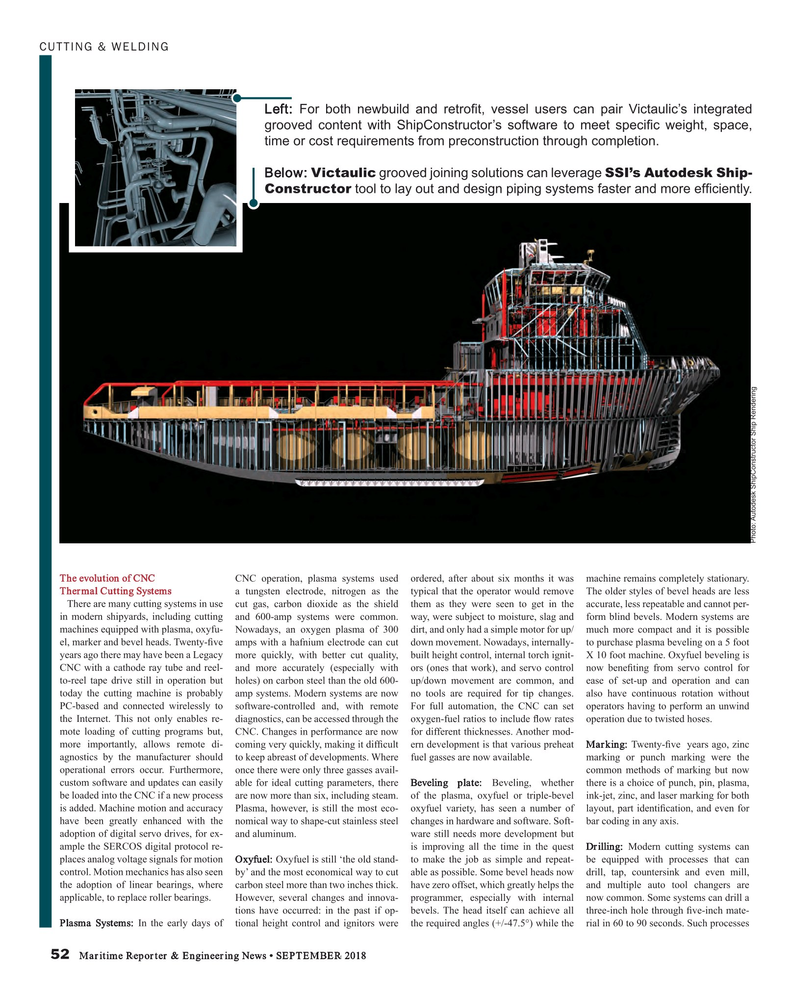
Page 52: of Maritime Reporter Magazine (September 2018)
Maritime Port & Ship Security
Read this page in Pdf, Flash or Html5 edition of September 2018 Maritime Reporter Magazine
CUTTING & WELDING
Left: For both newbuild and retro? t, vessel users can pair Victaulic’s integrated grooved content with ShipConstructor’s software to meet speci? c weight, space, time or cost requirements from preconstruction through completion.
Below: Victaulic grooved joining solutions can leverage SSI’s Autodesk Ship-
Constructor tool to lay out and design piping systems faster and more ef? ciently.
Photo: Autodesk ShipConstructor Ship Rendering
The evolution of CNC CNC operation, plasma systems used ordered, after about six months it was machine remains completely stationary.
Thermal Cutting Systems a tungsten electrode, nitrogen as the typical that the operator would remove The older styles of bevel heads are less
There are many cutting systems in use cut gas, carbon dioxide as the shield them as they were seen to get in the accurate, less repeatable and cannot per- in modern shipyards, including cutting and 600-amp systems were common. way, were subject to moisture, slag and form blind bevels. Modern systems are machines equipped with plasma, oxyfu- Nowadays, an oxygen plasma of 300 dirt, and only had a simple motor for up/ much more compact and it is possible el, marker and bevel heads. Twenty-? ve amps with a hafnium electrode can cut down movement. Nowadays, internally- to purchase plasma beveling on a 5 foot years ago there may have been a Legacy more quickly, with better cut quality, built height control, internal torch ignit- X 10 foot machine. Oxyfuel beveling is
CNC with a cathode ray tube and reel- and more accurately (especially with ors (ones that work), and servo control now bene? ting from servo control for to-reel tape drive still in operation but holes) on carbon steel than the old 600- up/down movement are common, and ease of set-up and operation and can today the cutting machine is probably amp systems. Modern systems are now no tools are required for tip changes. also have continuous rotation without
PC-based and connected wirelessly to software-controlled and, with remote For full automation, the CNC can set operators having to perform an unwind the Internet. This not only enables re- diagnostics, can be accessed through the oxygen-fuel ratios to include ? ow rates operation due to twisted hoses.
mote loading of cutting programs but, CNC. Changes in performance are now for different thicknesses. Another mod- more importantly, allows remote di- coming very quickly, making it dif? cult ern development is that various preheat Marking: Twenty-? ve years ago, zinc agnostics by the manufacturer should to keep abreast of developments. Where fuel gasses are now available. marking or punch marking were the operational errors occur. Furthermore, once there were only three gasses avail- common methods of marking but now custom software and updates can easily able for ideal cutting parameters, there Beveling plate: Beveling, whether there is a choice of punch, pin, plasma, be loaded into the CNC if a new process are now more than six, including steam. of the plasma, oxyfuel or triple-bevel ink-jet, zinc, and laser marking for both is added. Machine motion and accuracy Plasma, however, is still the most eco- oxyfuel variety, has seen a number of layout, part identi? cation, and even for have been greatly enhanced with the nomical way to shape-cut stainless steel changes in hardware and software. Soft- bar coding in any axis.
adoption of digital servo drives, for ex- and aluminum. ware still needs more development but ample the SERCOS digital protocol re- is improving all the time in the quest Drilling: Modern cutting systems can places analog voltage signals for motion Oxyfuel: Oxyfuel is still ‘the old stand- to make the job as simple and repeat- be equipped with processes that can control. Motion mechanics has also seen by’ and the most economical way to cut able as possible. Some bevel heads now drill, tap, countersink and even mill, the adoption of linear bearings, where carbon steel more than two inches thick. have zero offset, which greatly helps the and multiple auto tool changers are applicable, to replace roller bearings. However, several changes and innova- programmer, especially with internal now common. Some systems can drill a tions have occurred: in the past if op- bevels. The head itself can achieve all three-inch hole through ? ve-inch mate-
Plasma Systems: In the early days of tional height control and ignitors were the required angles (+/-47.5°) while the rial in 60 to 90 seconds. Such processes 52 Maritime Reporter & Engineering News • SEPTEMBER 2018
MR #9 (50-57).indd 52 MR #9 (50-57).indd 52 9/5/2018 11:56:55 AM9/5/2018 11:56:55 AM

 51
51

 53
53
